Abstract
Inflammation is an event of cellular defensive mechanism, which is usually triggered by various factors like pathogens, allergens, damaged cells and toxic compound. Inflammation results in remodeling and repairing of tissues followed by redness, swelling, heat, pain etc. When certain tissues are damaged by injury, pathogens or infections, the body’s immune system releases signaling molecules i.e. Cytokines and Chemokines, to carry the immune cells to the affected area. These immune cells along with WBC’s like Neutrophils and Macrophages, helps to remove the pathogens and allergens, also initiates the tissue repairing. There are two types of inflammation: Acute inflammation & Chronic inflammation. As inflammation is natural and necessary process for healing, Chronic inflammation is fatal. Body’s inflammatory response usually or can be influenced by various lifestyle factors such as diet, stress management, exercise, smoking & alcohol. Thus inflammation can be managed by healthy lifestyle, certain medications ( NSAID’S). Objective: The objective of the study is to formulate and evaluate spray using eucalyptus oil and rosemary as a key ingredient, aiming to harness its potential therapeutic benefits for Inflammation condition. Purpose: The purpose of this research is to develop a spray that will give potential anti-inflammatory effect, utilizing Eucalyptus oil, Rosemary & Calendula as a natural and potentially effective active ingredient. This spray will serve as a safer and effective for managing inflammation conditions.
Keywords
Anti-inflammation, Spray formulations, Active ingredients, Eucalyptus, Rosemarry, Calendula, Herbal constituents, Safety profile forms.
Introduction
Inflammation is a critical event of cellular defensive mechanism, which occurs in response to pathogens, allergens, damage of cells, loss of cellular tissue. It indicates tissue remodeling and repair. During inflammation, the activated macrophages produce reactive oxygen species (ROS) & reactive nitrogen species (RNS) that induces oxidation of nucleic acid, proteins and lipids (Bartsch and Nair,2004).
Etiology of Inflammation: The etiology of inflammation process begins with activation of monocyte cells which initiates the cascade of pro-inflammatory signaling pathways that leads to regulate downstream transcription factors such as Kappa 8 ( NF-kB) & interferon regulatory factor 1 (RF-1). These factors then cause induction of expression of pro-inflammatory cytokines such as interleukins (IL) including IL-1, IL-1?, IL-6 & tumor necrosis factor-? (TNF-?) ( Ashley et al. 2012; Jang-pangi, 2016; Menkin, 1936; Pearlman, 1999; Vinaya, 2013). Therefore, the need arise for safe, easily available and cost-effective treatments of inflammation disorder that led to exploration of plant-based drugs. Anti-inflammatory drugs are those class of medication that is designed to reduce inflammation in body, alleviating pain that is associated with swelling and other conditions. The discovery and development of anti-inflammatory drugs has revolutionized the treatment of inflammatory conditions, that provides relief to millions of people worldwide.
Symptoms:
1)Fever
2)Redness
3)Fatigue
4)Swelling
5)Loss of function
6)Heat
Causes:
- Injury: Physical trauma, cuts, burns, fractures, can damage tissue & trigger inflammation.
- Irritation: Exposure to substance like chemicals, pollutants, or allergens can cause inflammation.
- Infection: Pathogens such as bacteria, viruses, and fungi can trigger an immune response, causing inflammation.
Types:
Acute inflammation: It’s a rapid and short- term response to injury, or tissue damage, which is usually characterized by symptoms of redness, swelling, heat & pain at site of injury. E.g. cuts, bruises, sprains etc.
Chronic inflammation: It is a prolonged and constant immune response that can last for weeks, months. or years. It may arise with low-grade, asymptomatic or with symptoms such as fatigue, joint pain, & recurrent infections. It may damage tissues over time, that leads to tissue destruction, scarring, & impaired functions.
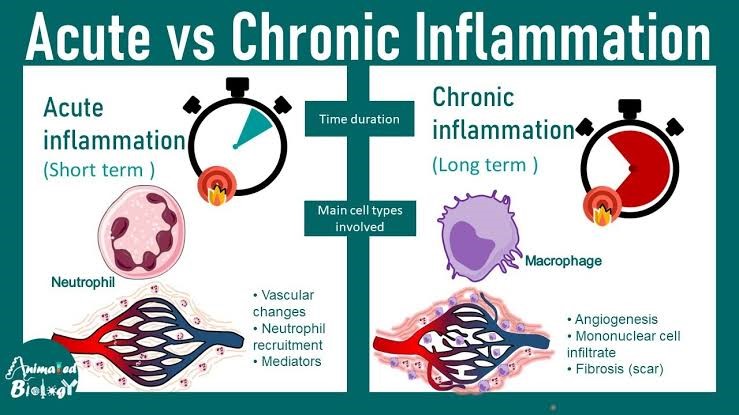
Fig:1
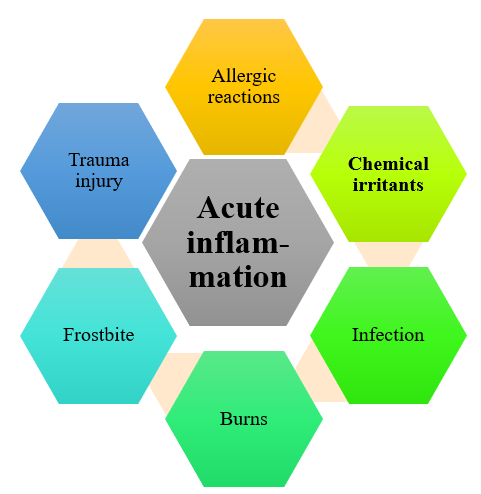
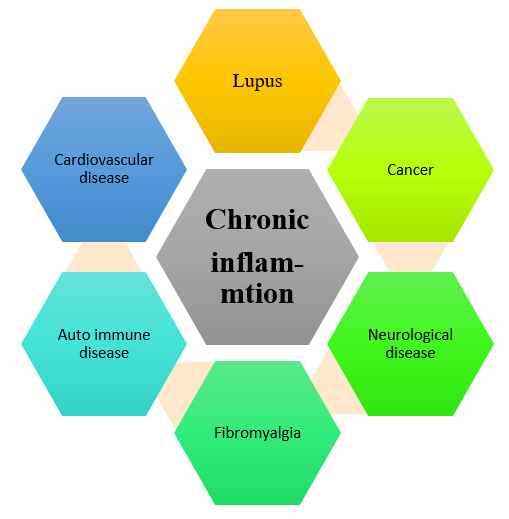
Fig:2
Mechanism of Inflammation: -
Inflammation is complex process that involves various cells and molecules in the body’s immune response. The key mechanism of inflammation is the release of inflammatory mediators i.e. Cytokines, Chemokines and Prostaglandins that response to tissue injury infection. These mediators work by attracting immune cells at the site of injury or infection, that leads to vasodilation, increase vascular permeability and the recruitment of leukocytes. In addition to this inflammation can be modulated by various signaling pathways which regulates the expression of genes involved in inflammation.
Mechanism of Action :-
1)Reduction of Inflammatory mediators: Anti-inflammatory sprays usually contain corticosteroids, which employs by blocking the production inflammatory mediators such as leukotrienes and prostaglandins. This aids in reducing inflammation and associated symptoms.
2)Inhibition of immune cell activation: Some sprays may contain Non-steroidal Anti-inflammatory drugs (NSAID’s) like ibuprofen & diclofenac, which inhibits the activity of enzymes called Cyclooxygenase(COX) which is responsible for production of Prostaglandins (which is an inflammatory mediators). In this way it blocks COX enzyme and reduces inflammation.
3)Local vasodilation: There are also some key ingredients in a spray that causes vasodilation, which results in increased blood flow to the affected area. In this way it will help to reduce inflammation.
4)Direct inhibition of inflammatory pathways: Some of sprays contain specific inhibitors that target a particular inflammatory pathways, such as inhibitors of NF-k? pathway involved in inflammation. These agents work by directly blocking the active key ingredient.
Components of Anti-inflammatory spray:
1)Corticosteroids: These are powerful anti-inflammatory agents that employs by suppressing immune response and reduce inflammation. E.g. Fluticasone, Hydrocortisone.
2)NSAID’s: These agents work by inhibiting the production of prostaglandins. E.g. Ketoprofen, Ibuprofen.
3)Local anesthetics: These agents numb the affected area, which provides immediate pain relief. E.g. Lidocaine, Benzocaine.
4) Counterirritants: In these ingredients like camphor, menthol, or capsaicin generates a cooling or heating sensation that distracts from pain and may help reduce inflammation.
5)Topical analgesics: The ingredients like salicylates, provide pain relief by blocking the transmission of pain signals from nerves.
- Eucalyptus oil:
- Botanical classification:
Kingdom: Plantae
Clade: Tracheophytes
Clade: Angiosperms
Clade: Eudicots
Clade: Rosids
Order: Myrtales
Family: Myrtaceae
Genus: Eucalyptus L Her
Species: Eucalyptus camaldulensis
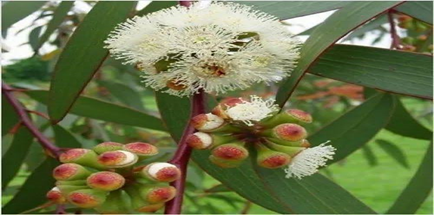
Fig:3
- Biological source: Eucalyptus oil is the essential oil obtained by distillation of fresh leaves of Eucalyptus globulus and other species.
- Chemical constituents: Chemical compound contained in the leaves of Eucalyptus globulus like ?-pinene, camphene, ?-pinene, ?-sabinene, limonene 1, 8-eucalyptul, cis-?-ocimene, y-terpinene, linalool, fenchol 1, 7, 7-trimethylbicyclo hept-5-en-2ol, pinocarveol, 5, 5-dimethyl-3-hylenebicyclo heptan-2-one.[29]. The essential oil components are camphor(9.58%), borneol (7.63%),1,8 cineole (51.25%) and camphene (3.77%). The most crucial compound with high concentration of 51.25% is 1,8 cineole, which is a cyclic ether having empiric formula C10H18O with systematic name of 1,3,3-trimethyl-2-oxabicyclo octane. This 1,8,-cineol is commercially known as the “ eucalyptol”.[30]
- Extraction Method: There are different methods through which the eucalyptus oil can be extracted viz.
a) Hydro-distillation: It is one of the traditional method of extraction of essential oils. It is the method in which the essential oil is evaporated by giving heat to the mixture of water & material (other solvents can also be used), then allow the vapors to liquefy in the condenser. The results obtained then flow into the separate room in which they will get separated into essential oil and water. It’s a quite simple method, & can be used for both large as well as small scale, also avoids chemical content loss due to long extraction process, and saves time and energy used. For the extraction of eucalyptus oil , 15 grams of sample is immersed in a 300 ml water and distilled for an about 5 hours. The oil is then extracted by hydro-distillation containing volatile compounds whereas the oil from SFE & Soxhlet contains volatile and higher molecular weight compounds. The eucalyptus oil yield from 3.1 at 1 hour to 3.8% at 5 hour is found.[26]
b) Steam distillation: This method is considered one of the standard method used for temperature-sensitive materials ( such as oil, resin, hydrocarbon etc.) insoluble in water, & decompose at its boiling point. It works by the mechanism of separation of compound or mixture of compound at its boiling point or below the boiling point of compound ( even close to the boiling point of water, 1000 C at atmospheric pressure) in order so that the volatile compounds whose boiling point of 150 to 3000 C can be evaporated water temperature. Now the vaporized water is passed to the material to be distilled without immersing the material in the water. Further, the compounds involved in water vapor enters the condenser and then are separated for its water and essential oil compounds. The essential oil after cooling at room temperature returns back to the liquid form, comes down the condenser and is collected in the container kept under, called separator. In this separator flask, the water is down and the essential floats above the water. The used for this extraction is, generally fresh or dry leaves with a yield of 1.0% - 2.4%. [25]
Benefits/Usefulness:
a) Anti-inflammatory: The essential oil of this compound can be used to applied as anti-inflammatory, analgesic & antipyretic [32]. Eucalyptol shows the inhibition of production and synthesis of TNF-?, Interleukin-1? (IL-?), leukotriene B4, & thromboxane B2 in human blood monocytes. It is shown that it is a potent cytokine blocker, which makes it suitable for long-term treatment of inflammation of the airways in bronchial asthma and other steroid-sensitive disorders. The anti-inflammation activity of this compound is applied for acute asthma patients & the success is been demonstrated as a mucolytic agent in upper and lower airways.[33].
b) Anti-bacterial: This compound also shows its effect in inhibiting the bacterial growth. The compounds which inhibit the bacterial growth are 1,8-cineole, linalool, and pinocarveol. On the basis of research, it has been showed that it could be used as an anti-bacterium on Staphylococcus aureus and Escherichia coli at a dose of 20µL.[31].
2)Rosemary officinalis:
- Botanical classification:
Kingdom: Plantae
Clade: Tracheophytes
Clade: Angiosperms
Clade: Eudicots
Clade: Asterids
Order: Lamiales
Family: Lamiaceae
Genus: Salvia
Species: S. Rosmarinus
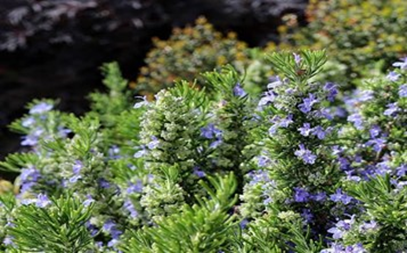
Fig no: 4
- Biological source: It is obtained from the flowering tops of leafy twigs of Rosmarinus officinalis.
- Chemical constituents: Some of characteristics chemical components of this plant include 1,8-cineole, ?-pinene, camphor, bornyl acetate, borneol, camphene, ?-terpineol, limonene, ?-pinene, ?-caryophyllene & myrcene.[27].
a) Microwave-Assisted Hydrodistillation: This distillation is carried out using an assembly consisting a domestic microwave oven, which is directly connected to a Clevenger- type extractor and a cooling system to condense the distillate continuously. In order to restore the water to the plant material, the excess condensed water is refluxed to the extraction flask. For performing extraction procedure take100 gm of rosemary sample and placed in a 2-litre flask containing distilled water (200ml), heat inside the microwave oven cavity, heat it at a fixed power of 600W until extraction of essential oils is done. The extracted oil is then dried under anhydrous sodium sulphate and stored in the dark until used for analysis.
b) Hydro distillation by Clevenger: For this method, to operate under optimal condition, add 100gm of rosemary to 800ml of distilled water in a 2-litre flask. Place the set in a balloon heater which is attached to a refrigerator to ensure condensation of essential oils for 3 hours. At the end, two phases were observed, an aqueous phase ( aromatic water) & an organic phase ( essential oil), that is less dense than water. Now collect the essential oil, dried under anhydrous sodium sulphate, and stored in sealed vials in the dark, around at 40C, until used.
a) Anti-inflammatory: The non-pharmaceutical methods to reduce pain and inflammation is not well studied. Whereas, the preliminary evidence suggests that rosemary oil may help in reducing tissue inflammation which leads to swelling, pain & stiffness. It may work by stemming the migration of wbc’s to injured tissues in order to release inflammatory chemicals. In the condition called Rheumatoid arthritis (an autoimmune disease) where body’s own immune system attacks tissues, such as knees and other joints, injuring the joint lining and causing inflammation. So, when people with this condition given 15 min knee massage using rosemary oil blend three times weekly, they showed a 50?crease in inflammatory knee pain in just 2 weeks.
b) Pain reliever: The rosemary can be used as a mild pain reliever. It also has non pharmaceutical adjunct to pain management. When the stroke survivors with shoulder pain is give a rosemary oil blend acupressure for 20 min twice daily experienced a 30% reduction in pain.
3)Calendula:
- Botanical classification:
Kingdom: Plantae
Clade: Tracheophytes
Clade: Angiosperms
Clade: Eudicots
Clade: Asterids Order: Asterales
Family: Asteraceae
Genus: Calendula
Species: Calendula officinalis
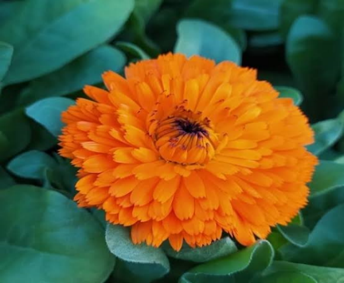
Fig no: 5
- Biological source: Calendula flowers are derived from Marigold Calendula officinalis L.
- Chemical constituents: Flavonoids (such as quercetin, kaempferol & isorhamnetin. Triterpenoids (faradiol esters, lupeol constitute around 0.1% to 0,5%) Carotenoids pigments ( lutein, zeaxanthin, beta-carotene) at concentrations of 0.05% to 0.2%. Saponins may ranges from 0.1% to 0.5% of plant material. Polysaccharides ( such as arabinogalactans, pectin) are present at a concentration of about 0.1% to 0.5%.Essential oils are present at a level of 0.1% to 0.5% or lower. Phenolic acid compounds ( such as caffeic acid, chlorogenic acid & rosmarinic acid) in range of 0.05%-0.3% is present. Alkaloid are found in traces (less than 0.01%).
- Extraction methods:
- Maceration extraction method:
A) Collection of plant: a)The flowers of plant Calendula (Marigold) were collected from different areas.
b) The flowers were allowed to dried in a sunlight for an about 24 hours.
c) Once drying was completed, the homogenate is transferred into a fine powder using electric mixer.
d) Collect the fine powder and store in packed container.
B) Preparation of plant extract:
Take around 50gm of fine powder of flower of Calendula ( Marigold) and place in 500 ml beaker for maceration method.
Perform the extraction with 300ml of ethanol for 72 hrs. Room temperature 300C.
Filter the extract using whatmann filter paper no.41 (110mm), then store the filtered extract in a beaker.
a)Anti-inflammatory: calendula’s triterpenoids esters fatty acids is responsible for its anti-inflammatory effects. It can help to reduce inflammation and speed up wound healing.
b)Antimicrobial: calendula has antimicrobial properties and can help treat skin infections.
c)Other uses: stomach upset, ulcers, menstrual cramps ( but there is no scientific evidence that it works for these problems).
Evaluation test for the herbal sprays:
1)Physical Evaluation:
Following physical parameters are used to for evaluation:
- Color: The color of the spray was observed by visual examination.
- Odor: It is to be evaluated by smelling (usually characteristics odor).
- State: It is visually examined.
2)pH: It should fall between the range of 5.5 to 6.0 which will signify that the formulation will not cause any irritation to skin.
3)Irritancy Test: Mark an area (1sq,cm) on the left-hand dorsal surface. Apply the spray, note the time. Irritancy was checked.
a) Localized relief
b) Quick absorption
c) Convenience
d) Reduced side effects
e) Non-invasive
f) Suitable for sensitive skin
g) Reduced risk of drug interactions
h) Precise dosage
I) Applicability to various conditions
j) Improved compliance
Applications:
1)Arthritis: Anti-inflammatory sprays can be applied directly to the affected joints to reduce pain & inflammation.
2)Muscle strains: Sprays can be used to alleviate pain & inflammation caused by muscle strains or overdue injuries.
3)Tendonitis: When tendons become inflamed due to overuse or injury, anti-inflammatory sprays can help reduce swelling & pain, promoting healing.
4)Bursitis: Bursitis, inflammation of fluid-filled sacs (bursae) that cushions joints, can be relieved by applying anti-inflammatory spray directly to that area.
5)Sport injuries: Athletes often use anti-inflammatory spray to manage pain & inflammation.
6)Back pain: The sprays help to provide relief from targeted back pains or spine pain.
REFERENCES
- Neukirch, H.D’ Ambrosia , M .; Dalla , V.J. ; Guerriero , A. Simultaneous quantitative determination of eight triterpenoid from flowers of 10 varieties of Calendula officinalis L. and characterisation of a new triterpenoid monoester. Phytochem. Anal. 2004,15 , 30-35.
- Jadoon, S. ; Bin, A. M. H. ; Akram, M.R. ; Khan, A.K. ; Malik, A. ; Chen, C.; Murtaza, G. Anti-Aging potential of phytoextract loaded pharmaceutical creams for human skin cell longevity . Oxid. Med. Cell. Longev. 2015, 2015, 709628. International Journal of Research Publication and Reviews, Vol (5), Issue (6), June (2024) , Page – 1514-1522-1522.
- Komissarenko, N.F. ; Chernobai, V.T.;Derkach, A.I. Flavonoids of inflorescences of calendula officinalis. Chem. Nat. Compd. 1988,24,675-680 .
- Preethi, K.C.; Kuttan, R. Anti-inflammatory activity of flower extract of Calendula officinalis Linn. and its possible mechanism of action. Indian J. Exp. Biol. 2009, 47, 113-120.
- Andersen, F.A.; Bergfeld, W.F.; Belsito, D.V.; Hill, R.A.; Klaassen, C.D.; Liebler, D.C.; Marks, J.G., Jr.; Shank, R.C.; Slaga, T.J.; Snyder, P.W. Final report of the cosmetic ingredient review expert panel amended safety assessment of Calendula officinalis-derived cosmetic ingredients. Int. J. Toxicol. 2010, 29, 221–243.
- Stegemann, S. Patient centric drug product design in modern drug delivery as an opportunity to increase safety and effectiveness. Expert. Opin. Drug. Deliv. 2018, 15, 619–627.
- Della Loggia, R. ; Tubaro, A. ; Sosa, S. ; Becker, H. ; Saar, S.; Issac, O. The role of triterpenoids in the topical anti-inflammatory activity of calendula officinalis flowers. Planta. Med. 1994, 60, 516-520.
- Gorchakova, T.V.; Suprun. I.V.; Sobenin, I.A.; Orekhov, A.N. Use of natural products in anticytokine therapy. Bull. Exp. Biol. Med. 2007, 143, 316-319.
- Wadsworth, T.L.; Koop, D.R. Effects of the wine polyphenolics quercetin and resveratrol on pro-inflammatory cytokine expression in RAW 264.7 macrophages. Biochem. Pharmacol. 1999, 57, 941-949.
- Kim, S.; Jung, E.; Kim, J.H.; Park, Y.H.; Lin-Shiau, S.Y; Chen, C.F. ; Lin, J.K. Suppression of inducible cyclooxygenase and inducible nitric oxide synthase by apigenin and related flavonoids in mouse macrophages. Carcinogenesis 1999, 20, 1945-1952.
- Zhao S, Zhang D 2014 Supercritical CO2 extraction of Eucalyptus leaves oil and comparison with Soxhlet extraction and hydro-distillation methods Separation and Purification Technology 113 443-451 CRC Press chapter 3 pp 43-58 7.
- Juhás, Š., Bukovská, A., ?ikoš, Š., Czikková, S., Fabian, D., Koppel, J., 2009. Anti-inflammatory effects of Rosmarinus officinalis essential oil in mice Acta Vet. Brno 78, 121-127. https://doi.org/10.2754/avb200978010121.
- Ashley, N.T. Weil, Z.M., Nelson,R.J., 2012. Inflammation: mechanism , costs, & natural variation. Ann. Rev. Ecol. Evol. Syst. 43, 38, 5-406. https://doi.org/10.1146/ annurev-ecolsys-040212-092530.
- Song A, Wang Y. Liu Y 2009 study on the chemical constituents of the essential oil of the leaves of Eucalyptus globulus Labill from China Asian Journal of Traditional Medicines 4 4 134- IOP Conf. Series : Earth and Environment Science 733 (2021) 012103 IOP Publishing. doi: 10. 1088/1755-1315/733/1/012103
- Ghalem B R, Mohamed B 2008 Antibacterial activity of leaf essential oils of Eucalyptus globulus and Eucalyptus camaldulensis African Journal of Pharmacy and Pharmacology 2 10 211–215.
- Silva J, Abebe W, Sousa S M, Duarte V G, Machado M I L, Matos F J A 2003 Analgesic and anti-inflammatory effects of essential oils of Eucalyptus Journal of Ethnopharmacology 89 2– 3 277–283.
- Juergens U R, Dethlefsen U, Steinkamp G, Gillissen A, Repges R, Vetter H 2003 Anti-inflammatory activity of 1.8-cineol (Eucalyptol) in bronchial asthma: A double-blind placebo-controlled trial Respiratory Medicine 97 3 250-256.


 Priya Wagh *
Priya Wagh *
 Trupti Mokase
Trupti Mokase
 Pratik Surse
Pratik Surse






 10.5281/zenodo.14607699
10.5281/zenodo.14607699